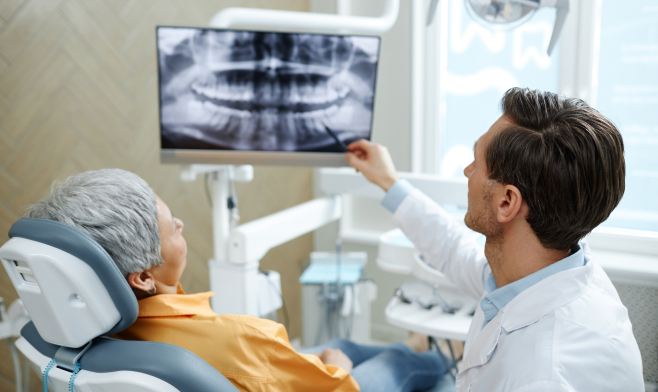Bone grafting plays a crucial role in the success of dental implants and periodontal treatments, and the type of graft material used can significantly impact the outcome. Whether you’ve experienced it firsthand or know someone who has, understanding which material is best for bone regeneration is key to long-term oral health.
In this article, we’ll explore the top bone graft materials for dental implants and how they contribute to lasting dental success.
What Are the Different Types of Bone Graft Materials?
Bone graft materials for dental implants fall into four main categories:
- Autografts: Bone taken from the patient’s own body. This is often considered the best bone graft for periodontal surgery, as it’s the best capability of bone regeneration.
- Allografts: Bone donated from another human. These grafts are usually considered as bone fillers and they are processed to create a matrix for bone regeneration.
- Synthetic Materials: Man-made materials that can be used for bone grafting. These materials are often biocompatible and can be a good option for certain patients.
- Xenografts: Bone from another species, typically bovine (Cow Bone). While they are commonly used, they can be effective in certain cases like areas of the jaw with low bone density since Bovine bone is denser than human bone.
The ideal bone graft materials for dental implants can depend on several factors, including the patient’s health, the severity of bone loss, the procedure being performed, and personal preferences. Your dentist can review these factors with you and determine the right option.
How Do Different Bone Graft Materials Support Dental Implants?
For long-term success, dental implants need a healthy jawbone. In cases where the jawbone has deteriorated due to tooth loss or other factors, bone grafting is typically performed before implant placement. It’s been noted that over half of patients who get implants may need a bone graft first. Bone grafts help strengthen and support bone regeneration for dental implants.
Autografts: The Gold Standard
While autografts, which use the patient’s own bone, are often considered the best bone graft for dental implants, allografts have also proven to be highly effective. In some studies, autografts, allografts, and xenografts have shown overall success rates of 100%.
Allografts: A Highly Effective Alternative
Allografts, derived from human donor bone, provide a natural scaffold that encourages the patient’s own bone cells to grow and integrate with the graft. This process, known as osteoconductivity, helps to rebuild and fortify the jawbone over time.
Xenografts: Animal-Based Option
Xenografts are derived from non-human sources, typically bovine (cow) or porcine (pig) bone. Xenografts have the advantage of being readily available and avoiding the need to harvest bone from the patient or a human donor. However, their acceptance and integration can be slightly slower compared to autografts.
Synthetic Bone Grafts: A High-Tech Solution
Synthetic bone grafts, composed of materials like hydroxyapatite or tricalcium phosphate, mimic the structure and composition of natural bone. These osteoconductive properties also stimulate the body’s natural bone regeneration process, supporting the stability of dental implants.
Comparing Synthetic vs. Natural Bone Graft Materials
Natural Grafts (Autografts and Allografts):
- Highly compatible with the body
- Stimulate the growth of new bone tissue
- Offer more predictable results
- Provide a strong and durable foundation
- Have a lower risk of infection
Synthetic Grafts:
- Can be used in various procedures
- Often more readily available
- No risk of disease transmission
- Resorb at a predictable rate
- May be more affordable
Ultimately, your dentist will weigh potential benefits and select a bone graft material based on factors like individual health, procedure goals, and material availability.
What Factors Should Be Considered When Choosing a Bone Graft Material?
Choosing the ideal bone graft material can be like finding the right puzzle piece. Your dentist will first consider your oral health, including the presence of gum disease or other dental conditions. The extent of bone loss is also an important factor. Whether it’s a minor defect or a more substantial loss will impact the choice of graft material.
Other bone graft considerations include the type of procedure. To select the best bone graft material for periodontal surgery, the material must be capable of integrating with the existing bone structure and stimulating new bone growth.
For dental implants, a bone graft helps create a strong foundation for the implants to integrate. In cases of tooth extraction, bone grafting can prevent jawbone collapse. For sinus lifts, it provides additional space for implants.
Which Bone Grafting Material Is Right for You?
At Poway Perio, we specialize in personalized periodontal care. When you come to us, we’ll assess your individual needs to find the best bone graft material for bone regeneration. To take the first step, contact us to schedule a consultation.





